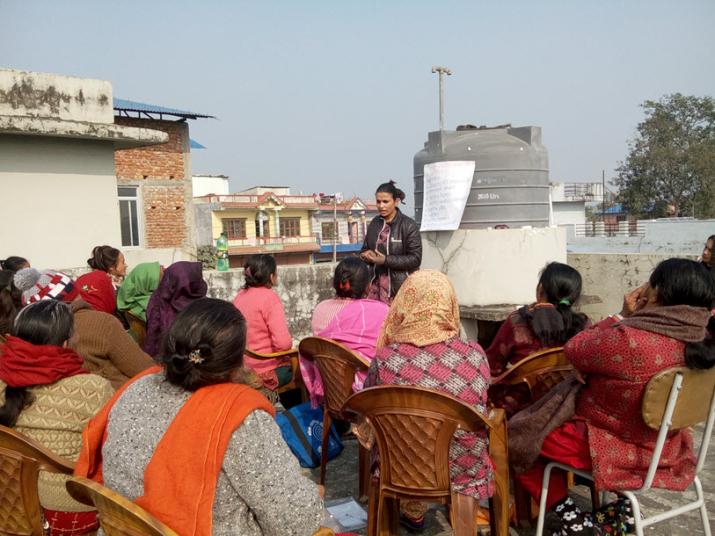
Mental heath trainings for community health providers in Nepal demonstrate how to modify approaches to reproductive health care for women with perinatal depression, post-partum psychosis and harmful alcohol use. These approaches are informing new models of syndemic care. Photo courtesy of Alisha Rijal, TPO Nepal.
Published March 7, 2017 under Research News
A new series of papers on "syndemics" just published by The Lancet provides an innovative way to think about how diseases cluster together within certain populations. Brandon Kohrt, assistant professor of psychiatry, global health and cultural anthropology, co-authored one of the articles in the series.
The Lancet papers show how the concept of syndemic combines notions of “synergy” with “epidemic” to offer a different framework for thinking about—and reacting to—health and healthcare inequities. While the notion of epidemic marks the distribution of a disease across a population, the notion of syndemic incorporates three core concepts:
- Two or more diseases cluster together within a population
- These diseases interact, often biologically
- Large-scale social forces give rise to them
Rarely does an epidemic work in isolation across a population, especially when it encounters poverty, social exclusion, gender-based violence, climate change, displacement to agricultural or industrial waste and other forms of social and environmental stress.
“In many cases, the convergence of social and health conditions encumber social lives, complicate one or more diseases and unequivocally shape illness experiences and worsen health outcomes,” said Emily Mendenhall, assistant professor of global health at Georgetown University and lead author of the series.
One example is syndemic clustering of HIV and tuberculosis. The diseases interact biologically in that HIV leaves the immune system more vulnerable to viruses such as tuberculosis. The diseases interact on a social level as well, through structural vulnerabilities such as living in close quarters and poor healthcare access.
These effects are amplified in populations facing extreme vulnerabilities, such as refugees or unauthorized migrants, or groups facing poverty or gender-based violence. Delayed medical attention can further impede diagnosis and escalate medical and social problems.
Mendenhall emphasized the policy relevance of using “syndemics” to understand ill health of impoverished communities. “By recognizing syndemic clusters, policies that improve education and housing conditions, enhance social cohesion and provide more community-based support could plausibly enhance health outcomes for diseases that syndemically interact,” she said. “This makes a big impact especially when similar forces—like wealth inequality or persistent financial or food insecurity—serve as motivators of more than one condition.”
The papers also detail the approach described as “syndemic care,” in which health systems focus on providing holistic medical care as opposed to care focused on singular disease outcomes. Adding the social element into clinical care can improve patient outcomes by recognizing the underlying social, economic, and psychological factors impede treatment. It also incorporates diagnostics and routine care into one medical visit, saving the patient time and money.
Recognition of syndemics promotes the need to build strong health systems that are accessible, affordable, and available for vulnerable populations worldwide. Mendenhall adds that “by addressing the social and economic drivers of health inequities, we can radically transform the distribution of suffering and ill health globally as well as in the United States.”
Kohrt’s Contribution to the Series
In the series paper co-authored by Duke Global Health Institute faculty member Brandon Kohrt, the authors examine the application of syndemic theory to comorbidities and multi-morbidities in low-income and middle-income countries. They discuss the comorbidity of diabetes with HIV in Kenya, tuberculosis in India and depression in South Africa, and they illustrate the different syndemics across these countries and the potential benefit of syndemic care to patients.
Kohrt combined his experience as a psychiatrist and his global health research to develop the model of syndemic care with Mendenhall. He explains, “As a clinician, I’ve seen how approaches to diabetes management fail when we ignore a patient’s depression. Similarly, my treatment of patients with depression needs to be adjusted when the patient has or is at high risk for diabetes.”
Globally, Kohrt says, it’s becoming clear that single disease approaches to clinical care, epidemiological modeling, and health policy can’t adequately address the health problems of the majority of the world’s population—for whom co-morbidity and multi-morbidity are the rule more than the exception.
“This series brings together exemplary collaborative care models, anthropological theories, and innovative epidemiological methods to transform how we train health workers and deliver services in both high and low resource settings,” Kohrt said.


